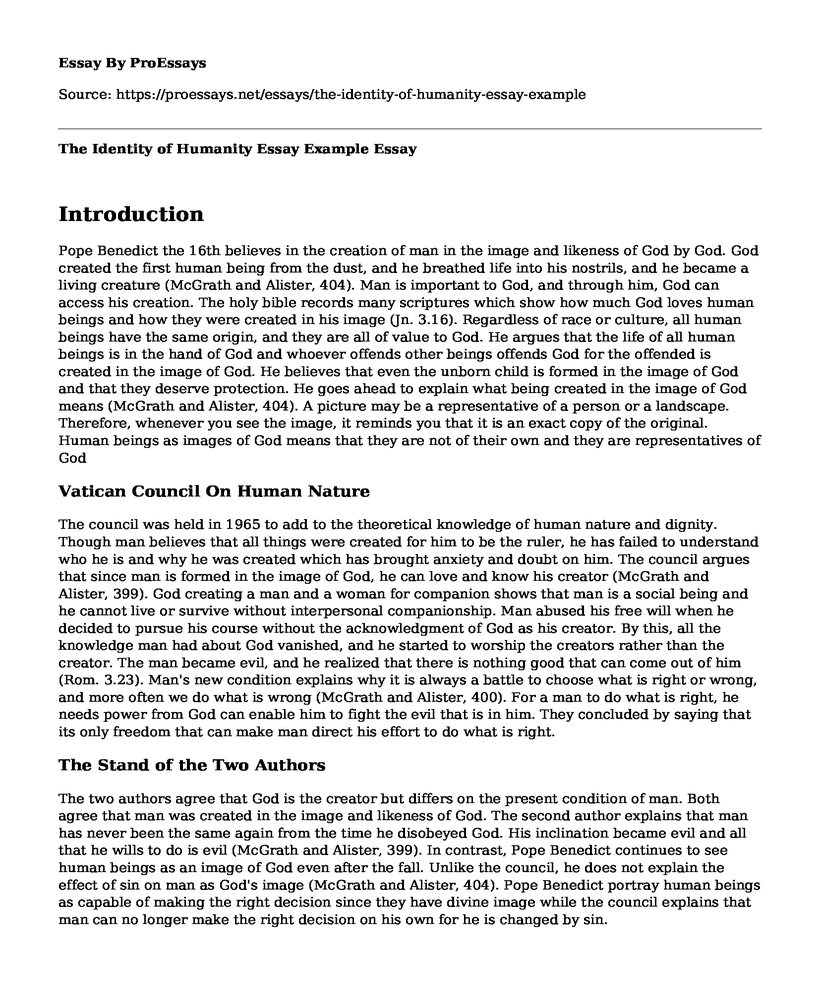Introduction
Pope Benedict the 16th believes in the creation of man in the image and likeness of God by God. God created the first human being from the dust, and he breathed life into his nostrils, and he became a living creature (McGrath and Alister, 404). Man is important to God, and through him, God can access his creation. The holy bible records many scriptures which show how much God loves human beings and how they were created in his image (Jn. 3.16). Regardless of race or culture, all human beings have the same origin, and they are all of value to God. He argues that the life of all human beings is in the hand of God and whoever offends other beings offends God for the offended is created in the image of God. He believes that even the unborn child is formed in the image of God and that they deserve protection. He goes ahead to explain what being created in the image of God means (McGrath and Alister, 404). A picture may be a representative of a person or a landscape. Therefore, whenever you see the image, it reminds you that it is an exact copy of the original. Human beings as images of God means that they are not of their own and they are representatives of God
Vatican Council On Human Nature
The council was held in 1965 to add to the theoretical knowledge of human nature and dignity. Though man believes that all things were created for him to be the ruler, he has failed to understand who he is and why he was created which has brought anxiety and doubt on him. The council argues that since man is formed in the image of God, he can love and know his creator (McGrath and Alister, 399). God creating a man and a woman for companion shows that man is a social being and he cannot live or survive without interpersonal companionship. Man abused his free will when he decided to pursue his course without the acknowledgment of God as his creator. By this, all the knowledge man had about God vanished, and he started to worship the creators rather than the creator. The man became evil, and he realized that there is nothing good that can come out of him (Rom. 3.23). Man's new condition explains why it is always a battle to choose what is right or wrong, and more often we do what is wrong (McGrath and Alister, 400). For a man to do what is right, he needs power from God can enable him to fight the evil that is in him. They concluded by saying that its only freedom that can make man direct his effort to do what is right.
The Stand of the Two Authors
The two authors agree that God is the creator but differs on the present condition of man. Both agree that man was created in the image and likeness of God. The second author explains that man has never been the same again from the time he disobeyed God. His inclination became evil and all that he wills to do is evil (McGrath and Alister, 399). In contrast, Pope Benedict continues to see human beings as an image of God even after the fall. Unlike the council, he does not explain the effect of sin on man as God's image (McGrath and Alister, 404). Pope Benedict portray human beings as capable of making the right decision since they have divine image while the council explains that man can no longer make the right decision on his own for he is changed by sin.
Conlusion
In summary, I agree with the second author for he presents the whole history of man from creation to his fall. The council argues that we have disobeyed God and there is no power in us to do what is right. This explains why one has to battle so much before making the right decision while it is so easy to do what is wrong. Pope Benedict leaves human beings as perfect, and he does not explain the effect of sin on us. Just like the council, I believe evil is intertwined in our blood, and no matter how much we try to do what is right we are not able to do it on our own (Fortin Dennis and Ellen, 18). We must rely on the power that is beyond us to attain perfection.
Works cited
Fortin, Denis, and Ellen Gould Harmon White. "Ellen G. White's Steps to Christ: Historical Introduction and Notes." (2017).
McGrath, Alister E., ed. The Christian theology reader. John Wiley & Sons, 2016.
Version, King James. Holy Bible. Arcturus Publishing Limited, 2017.
Cite this page
The Identity of Humanity Essay Example. (2022, Dec 04). Retrieved from https://proessays.net/essays/the-identity-of-humanity-essay-example
If you are the original author of this essay and no longer wish to have it published on the ProEssays website, please click below to request its removal:
- Paper Example on Servant Leadership
- Cooperate Philanthropy Essay
- Ethics of Decision Making Paper Example
- Christian Nature of Spirituality Essay Example
- Failure Is a Better Teacher Than Success Essay
- Essay Example on God: Unchanging, Everywhere, Personified, Righteous, & Holy
- Essay Sample on Whether Abortion is Morally Justifiable







